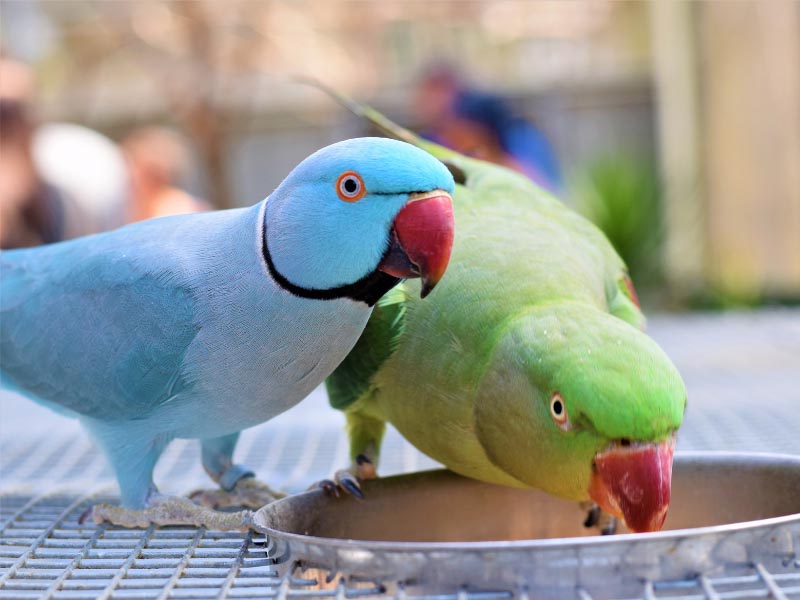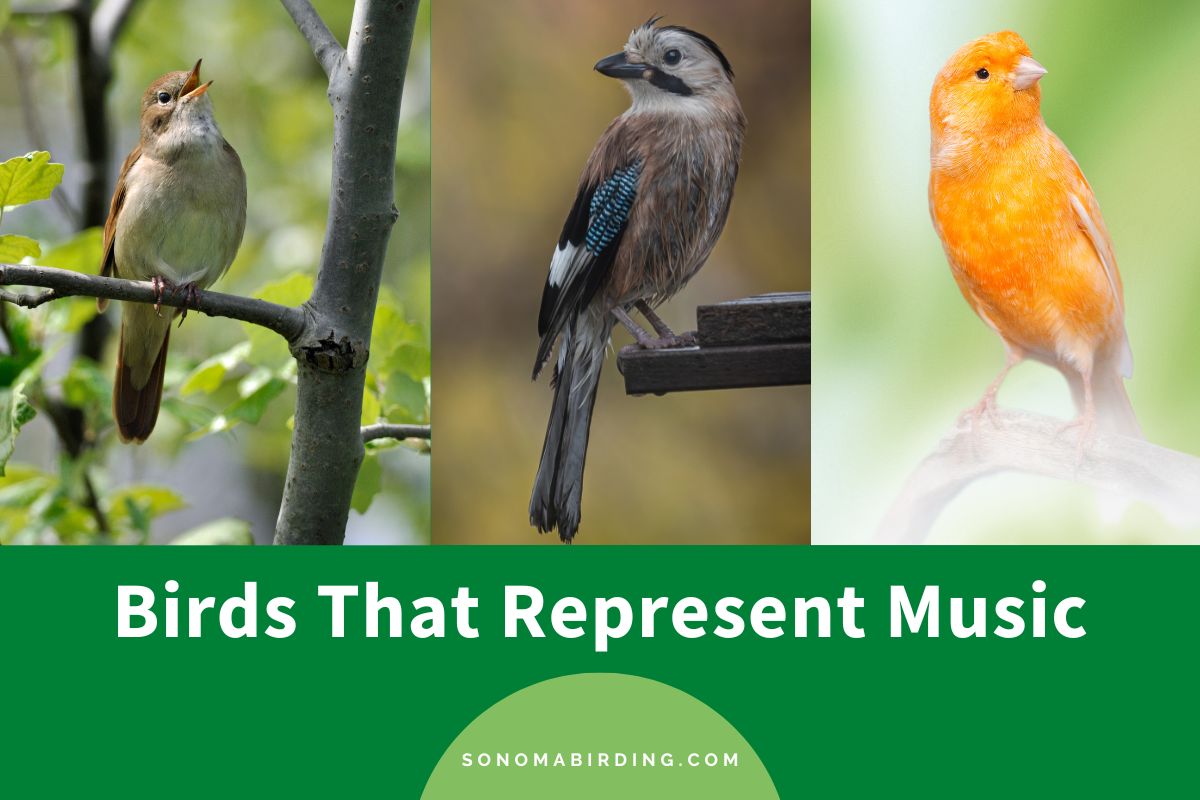There are countless forms of art practiced in the world today, but only a few have come as close to receiving a universal appeal as music. This timeless art is most popular because of how it’s enjoyed equally by its creator and spectators; at times, even more so by the latter.
While music is defined as a form of art, it’s capable of much more. And we aren’t the only ones saying that. Several studies have shown that it can lower the level of our stress hormones (cortisol), uplifts our moods, and help us sleep better. One study has also proved that it can also boost our memory!
But the real question here is: Does music do all that solely for humans, or can other living beings benefit from it, too? Well, in matters like these, the birds are quite ahead of us. These avian creatures have been creating and enjoying music much longer than us: through their songs.
In today’s article, we’ll talk about 6 different birds that have contributed to the popularity of music not only in their world but also in ours. For these reasons, we see them as the symbolism of music in the avian world. Excited to learn about these winged musicians? Then let’s get started!
1. Nightingales

Belonging to the family of the Old World Flycatchers, the nightingales are tiny passerine birds that dwell in the Palearctic. These migratory birds breed in Europe, Asia, and northwestern Africa, while their winter habitats are limited to the sub-Saharan regions of Africa.
Although the nightingales do not naturally occur in the Americas, it’s their melodious voice that has made them well-known throughout the continents. And we’re not talking about just the present; the connection between music and nightingales was recognized by humans a long time ago.
The evidence of association lies in the bird’s name itself. Nightingale has been derived from the Old English term nihtegale, which roughly translates to night songstress. And indeed, the nightingales sing their sweetest songs in the darkness of the night, a trait that also lends their personality a certain mysterious touch.
The association of nightingales and music is also seen in various literary works. Take the Ode to a Nightingale for instance; in the poem, John Keats marvels at how these birds live in their own world, flying around and singing melodious, sorrowful songs. Keats also expresses his envy at how the songs of these birds make them immortal, while he himself is destined for such a short, inconsequential life.
In light of all these references, it’s evident that nightingales are the most important representatives of music in the bird kingdom.
Fun fact: Although most stories and folklores describe Nightingales as females, ironically, it is the male nightingale that sings.
2. Mockingbirds

The mockingbirds are a group of passerine birds belonging to the family of the Mimids. Although there are 16 species of these birds in the world, only one is a common sight throughout North America, which is the Northern Mockingbird.
Just like the nightingales, these birdies also tend to enjoy singing at night, which is why their songs are often heard past midnight. But if you ever spot a mockingbird singing during the daytime, know that they’re a young male seeking a mate desperately.
One important difference between nightingales and mockingbirds (in terms of music) is that, unlike the former, both sexes of mockingbirds are active singers. And these birds wouldn’t repeat the same song repeatedly, either.
Their song library is surprisingly diverse, consisting of hundreds of different songs. Studies show that these birds continue to learn new songs all their lives; if they were humans, we’d call them scholars of music.
In fact, in addition to singing their own songs, the mockingbirds can do much more. As you might’ve gathered by their name, they’re also great mimics and can imitate the sounds produced by numerous other birds, insects, and amphibians living around them. The most common victims of their imitation are hawks, jays, shrikes, and orioles.
In the world of symbolism, the spirit of mockingbirds is so consumed with music that, in addition to creating its own, it also adapts the music created by others. If this isn’t true devotion towards music, we don’t know what else can be.
3. Canaries

A group of tiny songbirds belonging to the Finch family, the canaries are one of the most popular cage bird choices throughout the world. But do you know what makes them such desirable house pets, besides their tiny size and bright, colorful appearance? It is their sweet, melodious songs that are known to have a soothing effect on anyone who listens in.
The canaries produce a soft, bubbly song that sounds very much like water rolling, with occasionally droplets falling into a barrel. This description itself seems to have been snatched out of beautiful poetry, just like their songs.
Among both sexes of canaries, only the males are known to sing naturally; this singing is also an attempt to attract a mate. Unlike most birds that sing vigorously during summers, the canaries are found singing most actively during fall and winter. In the summertime, when they undergo a molt, you’ll rarely find them with enough energy to sing.
The songs of the canaries are symbolic of the fact that music is subjective. It doesn’t confide in any strict norms or notions and is independent in spirit and form.
4. American Robins

Belonging to the family of the true thrushes, the American Robins are migratory songbirds with an abundant population scattered all over North America. These are highly vocal birds; while only the males of the species are skilled singers, this doesn’t have any effect on the females, who continue to produce a variety of vocalizations alongside the males.
The songs of American Robins are seen as an important sign that marks the arrival of spring. These tenacious songbirds can be heard all day long; the males first sing to attract a partner but continues to do so long after the mating rituals have concluded. This trait sets them apart from the other songbirds.
Male robins also sing as their partners are incubating the eggs as if to celebrate the new lives that they’re bringing to the world.
Another peculiar trait that the robins living in urban areas have developed is nocturnal singing. But if they’re diurnal birds, why would they sing at night? We’ll tell you.
Robins are used to their songs reaching far and wide. But as they sing in the urban areas during the daytime, the hustle and bustle of the vehicles being driven around often drown out their songs. This is unacceptable to the robins to the extent that they’ve changed their entire routine to prevent their songs from being lost.
The spirit of these willful birds shows us how much music can drive you if you let it. Once you’ve tasted the true joy it brings, you’d never be able to let go.
5. Magpies

Magpies are a group of passerine birds belonging to the Corvid family that have a wide global distribution. These birds are popular for three qualities: their intelligence, their tendency to steal shiny objects, and lastly, their songs.
These corvids have the most complex vocalizations of all birds in the world and are also referred to as the Opera singers of the avian world.
Take the Australian Magpies, for instance. Although scientists have declared them to be unrelated to the other magpies, they’re known to produce a variety of complex calls, which sound distinct even to humans! When alone, they often produce musical warbles as if to amuse themselves.
Both sexes of magpies are equally skilled singers, and the pairs tend to sing in unison after the mating has ended. This is also referred to as caroling and is done to mark their territory.
To top that off, these magpies have also mastered the art of mimicry and can mimic over 30 different bird species found in Australia, in addition to mammals like horses and dogs. Having ticked both singing and mimicking off, is there anything else these birds cannot do?
6. Parrots

If you’re an avid birder, you must already have realized it, but parrots are the only birds on our list that aren’t true songbirds. For those of you who aren’t familiar with the concept, all songbirds have a unique vocal organ called the syrinx that helps them carry a musical tune.
However, in the case of parrots, this organ is absent, which is why they’re not called songbirds. But have you wondered how they’re able to sing despite this fact? Well, the straightforward answer is that what these birds might lack in vocal organs, they make up for in their mimicry skills.
These clever birds can imitate almost any sound they hear and put it to good use when learning songs. And while their songs might not have that inherent sweetness of songbirds, they’re still pleasing to us. You might not have noticed it, but the pleasantness of their voice is derived more from how happy they are while singing.
Yes, you read that right. Because parrots aren’t songbirds, they don’t have the natural tendency to sing and will only sing when they’re in a good mood. This behavior is symbolic of how willingness can always trump skill. It also goes on to represent that music is not always about the melodies but also about the efforts and emotions put into creating it.
Wrapping it up
With this, we’ve reached the bottom of our article. Let us quickly revisit our learnings of the day before we part ways.
We began by talking about music, the art form enjoyed by such a vast population around the world. We also discussed how the influence of music on people isn’t merely accidental. Science has proof of it affecting the human brain in many positive ways, which is why it’s considered one of the best medicines in the world.
We later moved on to explore 6 birds that represent music. And while all the birds on our list are songbirds, the one that is the most popular pet choice globally, the parrot, isn’t.
5 Birds That Symbolize New Beginnings
Nightingale Symbolism and Spiritual Meaning (Totem, Spirit, and Omens)

